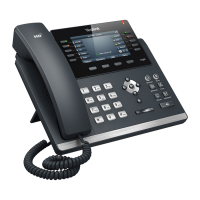Administrator’s Guide for SIP-T46G IP Phone
152
When registering to the working server, the IP phone must always register to the primary
server first except in failover conditions. When the primary server registration is
unavailable, the secondary server will serve as the working server.
SIP Server Domain Name Resolution
If a domain name is configured for a SIP server, the IP address(es) associated with that
domain name will be discovered through DNS as specified by RFC 3263. The DNS query
involves NAPTR, SRV and A queries, which allows the IP phone to adapt to various
deployment environments. The IP phone performs the NAPTR query for the SRV pointer
and service type (UDP, TCP and TLS), the SRV query on the record returned from the
NAPTR for the host name and the port number, and the A query for the IP addresses.
If a port is set to 0 and the transport type is set to DNS-NAPTR, NAPTR and SRV queries
will be tried before falling back to A queries. If no port is found through the DNS query,
5060 will be used. If an explicit port (except 0) is specified and the transport type is set
to DNS-NAPTR, the only lookup will be an A query.
The following details the procedures of DNS query for the IP phone to resolve the
domain name of working server into the IP address, port and transport protocol.
NAPTR (Naming Authority Pointer)
First, the IP phone sends the NAPTR query to get the SRV pointer and service type. The IP
phone performs a NAPTR query for the domain name. The sample of the NAPTR records
for reference:
order pref flags service regexp replacement
IN NAPTR 90 50 "s" "SIP+D2T" "" _sip._tcp.example.com
IN NAPTR 100 50 "s" "SIP+D2U" "" _sip._udp.example.com
Parameters are explained in the following table:

